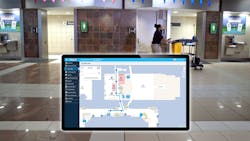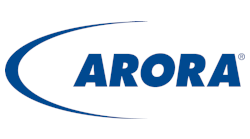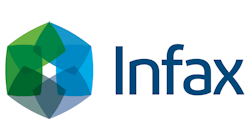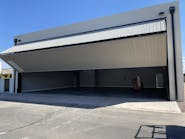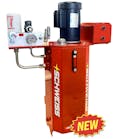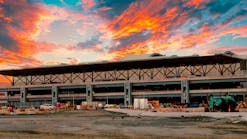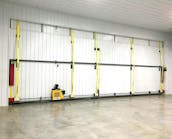Under the current conditions of our country and around the world, the importance of not only maintaining but strengthening our sanitation standards have been thrust to the forefront of public discourse. With thousands of individuals flying in and out of airports from places around the globe, and utilizing their facilities, they are undoubtedly viewed as spaces that require extra attention and care due to their consistent exposure. In addition, one of the most common areas we can identify for the spread of germs is a restroom. Consequently, airport stakeholders are quickly recognizing that clean, crowded restrooms are not only a significant aspect of the travel experience, they are becoming a huge factor in whether a passenger likes an airport.
Therefore, several questions are now being considered in ways they may not have been before, including:
- How often are our restrooms cleaned and sanitized, and how often should they be?
- How often do products need to be restocked to provide the most sanitary customer experience?
- How many people are using our facilities and how often?
- How could this data impact our extensive cleaning strategy and everyday activities?
As we look to address these concerns, we consider the increased use of technology to extract, analyze, and employ data wherever and whenever possible in these facilities.
Smart Restroom Technology
Airport restrooms are an excellent source of data for facility operators to examine and draw significant conclusions that can influence their decision making. The TRAX SmartRestroom solution gives insight into the status of your restrooms and overall custodial operations by providing predictive, real-time, and historical data analysis, pulled from sensors and dispensers, including but not limited to:
- Smart soap dispensers
- Smart towel dispensers
- Smart trashcan sensors
- Smart toilet paper dispensers
- Guest feedback tablets
- Throughput counting
- Air quality sensors
At any given time, data from these sources is collected and uploaded via a cellular or Wi-Fi connection. It is then sent to the TRAX Mobile and Desktop applications for users to view and study. Therefore, when implemented, this new smart restroom technology has the ability to help staff safeguard their restrooms, while also enhancing the passenger experience, streamlining operations, and influencing future design.
Utilizing Smart Restrooms
Safeguarding Restrooms
One of the primary indicators of a restroom’s status and cleanliness is the customer flow or the number of passengers that have visited that facility. It stands to reason that the greater the number of people who use a facility, without intervention from staff, the greater the likelihood of reduced resources (e.g. soap, towels, toilet paper) and undesirable conditions.
Using a throughput counter, TRAX SmartRestroom can analyze this data to establish necessary restroom, fixture, and safety updates to accommodate the customer flow. Using historical data analyses and artificial intelligence, operators can set a predetermined number of people who will use the restroom before replenishment of consumables are typically required. Once that threshold is reached, an alert is automatically sent to the custodian assigned to that area to clean the restroom and restock supplies. This creates a demand-based cleaning schedule, rather than a conventional, routine cleaning schedule.
TRAX SmartRestroom data can also quickly help resolve restroom issues with an application in place to manage work orders with assignments, drop pins for maintenance alerting, and staff routing on a facility map.
Enhancing the Customer Experience
Through a more consistent, reliable cleaning and restocking process and real-time alerts when restrooms require cleaning, the passenger experience can be significantly enhanced. Supplies will be readily available when expected and required and the facility itself will be able meet a traveler’s sanitation standards.
The actual process of visiting a restroom will also be improved by displaying real-time data to inform the public as much as possible. With the use of digital signage, travelers can now see whether the restroom is closed for cleaning, the next nearest restroom, and if custodial staff is present. Through the presentation of this data, passengers will feel more informed and better prepared throughout this specific leg of their journey.
Upon leaving the restroom, passengers can also rate its cleanliness and their overall experience using a survey tablet. This data can significantly influence real-time cleaning efforts, future cleanings schedules, and throughput counter thresholds.
Streamlining Operations and Inventory
The TRAX SmartRestroom analytics platform combines the data into an organized format, providing a number of metrics for stakeholders to review, including:
- Labor needs
- Staff scheduling
- Staff performance
- Guest feedback
- Inventory usage
- Throughput trends
- Inspection and quality control reports
To inform staff and inventory metrics, staff location data and work orders can be monitored and analyzed. Using the mobile application or Bluetooth badging, a custodian’s arrival and departure to a restroom can be monitored, showing the duration of their service. Before they begin their work, a custodian can rate the cleanliness of the restroom upon arrival, to better explain the status of a facility throughout the day. Staff also enter their completed tasks and the amount of inventory replenished during that session, to update the restroom’s status and to monitor inventory. Supervisors are alerted in real time to perform quality control assessments and run inspection reports through the TRAX mobile application.
Airport operators can also utilize data analytics to drive future restroom design and daily custodial operation, including:
- Determining restroom usage and capacity.
- Developing KPIs and SOPs to drive guest experience and ASQ scores.
- Determining whether your number of fixtures is meeting the demand.
- Understanding trends in workflow and peak travel hours.
- Driving design from patron data with the use of feedback.
Meeting the Challenges of Today’s Airports
Smart restroom technology is currently being employed at several airports across the country, including Hartsfield Jackson Atlanta International Airport (ATL), Boston Logan International Airport (BOS), Houston Airport System (HOU, IAH), and Dallas Fort Worth International Airport (DFW). These facilities have decided to improve their custodial operations with technology when it comes to establishing efficient operations, managing their inventory and labor, while also fostering a better experience for their passengers. Below are some of the problem statements that airports around the nation are using technology to address:
- Tracking passenger flow.
- Dealing with overly congested restrooms in certain terminals.
- Problems with adequate staffing during peak hours and dates associated with heavy travel.
- Keeping custodial operations teams accountable.
- Improving inventory and tracking processes.
- Increasing communication between numerous reporting systems that are already in place.
TRAX SmartRestroom has been able to address these problems by offering real time, historical, and predictive data that gives significantly detailed insight that was not available before. Passenger flow and adequate staffing are being monitored and adjusted with the use of throughput counters and smart sensors, while Bluetooth badging, location monitoring, and feedback reporting helps keep custodial teams responsible and on target with tasks and supplies.
It is important to note that this data is consistently being collected and compiled from various sources (allowing for communication across systems) and displayed on a convenient dashboard for stakeholders and operators to examine and inform their decision-making strategies. In this sense, this data provides the prospect to not only address current, obvious challenges, but also identify future areas of growth and opportunity.
The Future of Smart Facilities
The ultimate goal of this technology is to help businesses maintain their facilities and keep them at the standards that are expected of them. With new technologies and opportunities to gather data being discovered at a rapid pace, as we begin to implement these solutions, the future holds the possibility of connecting everything within a restroom and pulling real-time data on every aspect and asset available.
However, custodial work is not just limited to a restroom, especially within an airport. These solutions can be expanded beyond the restroom and implemented facility wide. The benefits of smart restroom technology can then be expanded to every aspect of an airport, such as check-in areas, security, concessions, shopping, and terminal gates. Using web and mobile applications to collect and analyze a wide variety of data, as well as view predictive flight data passenger counts, operators can finally streamline operations, manage resources and labor more efficiently, and significantly enhance the passenger experience for all those traveling through.
Tracy Davis is the Vice President of Infax, Inc. and the President and CEO of TRAX Analytics, LLC. She has over a decade of aviation experience focused in the realm of data analytics and software services and has worked with over 75 different airports in North America. Tracy is one of the co-creators of the TRAX Analytics platform for custodial and facility management and continues to oversee the development of the data analytics solution that supports over 15 airports nationwide.
